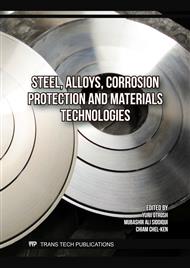p.3
p.15
p.27
p.37
p.47
p.59
p.75
p.87
Nanoindentation and Simulation Analysis of Deformation Behavior in Bulk Metallic Glass Alloy
Abstract:
Nanoindentation, an advanced technique employed for characterizing materials, facilitates the precise determination of their hardness and Young's modulus by applying a specific, controlled force through an indenter, enabling highly localized deformation and measurement at nanometer scales. The nanoindentation gives us the view of the isotropic and anisotropic features of the materials by analyzing the zone beneath the indenter. The application of Bulk Metallic Glass (BMG) alloy, renowned for its unique combination of high strength, exceptional elasticity, and superior corrosion resistance, spans diverse industries including aerospace, biomedical, and consumer electronics. The study focuses on conducting nanoindentation analysis on the BMG alloy, aiming to characterize its deformation behavior. This involved utilizing Scanning Electron Microscopy (SEM) to discern deformation characteristics, followed by validation of the findings through simulations, ensuring robustness and reliability of the results. The modulus, determined to be 227GPa, provided insight into the material's structural rigidity, and the hardness 14.8GPa offered an indication of its resistance to localized plastic deformation. The results have been compared with the simulation results where the modulus was 242GPa and the hardness was 16.1GPa.
Info:
Periodical:
Pages:
27-35
Citation:
Online since:
November 2025
Authors:
Price:
Сopyright:
© 2025 Trans Tech Publications Ltd. All Rights Reserved
Share:
Citation:


